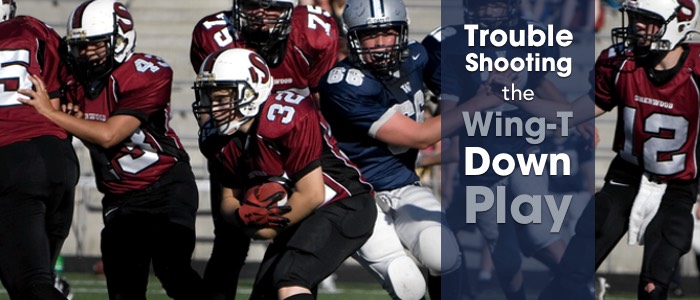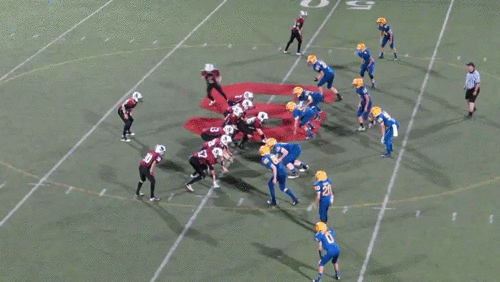Troubleshooting the Wing-T Down Play

You can get my free Belly Series playbook to follow along with the specific assignments for the Down play:
Download the Free Belly Series Playbook
Why write about troubleshooting a single Wing-T play? Because this play has been a go-to play for years in my offense, and not just for short yardage or to setup the Counter. We’ve won games running this down other teams’ throats.
Let’s start by reviewing the overall scheme for Right 36 Down.

Down is an off-tackle fullback play meant to hit quick and hard. The key blocks will come from the tight end, the play-side guard, and the play-side wingback. These are very easy blocks to teach and perfect: gap and down blocks for the TE, backer block for the wingback, and a cross-block kickout by the guard. All of these blocks can be taught with very similar shoulder technique as they will default to same-foot same-shoulder. That is, the TE will step down with his left foot and execute a left shoulder down block. The WB will step down with his left foot and execute a left shoulder block on the first LB he sees inside. The guard will step flat with his right foot and execute a right shoulder kickout block on the first man he sees outside the TE.
Here's a snapshot of what a pretty good executed Down play looks like (full video):

The QB footwork was covered in a prior post, but here’s a summary:
- Reverse pivot fast and flat to the LOS. He should be almost stepping on the heels of the playside guard.
- On second step (with right foot) he is reaching back to give ball to FB.
- On third step (with left foot) he is transferring weight from right foot to left foot to give the ball to the FB.
So, what can go wrong? Here are a few possibilities:
- Poor assignment understanding by the TE – The TE must understand his rule to be “down block left” and to ignore any player heads up to outside shade. Early in the season, despite drilling this over and over, I will review game film and find at least a few times when the TE is blocking on a heads up man or even blocking out and outside shaded DE. Reinforce that this is a team sport and the play had every player accounted for. The TE is most likely to make this mistake when there is nobody in his C gap or even heads up on tackle. Remind him to progress to next level and he can lay one on the Mike or Will backer. Here's an example of a TE blocking directly on instead of obeying his down rule.
- Poor gap and down block technique by the TE or playside tackle – B and C gap penetration will kill this play. Review my offensive line drills and make sure players understand that they should use a gap technique when faced with a penetrating lineman or linebacker. Here's an example of a poor TE down block, allowing C gap penetration.
- Poor backer block by the wingback – Your running backs probably aren’t getting nearly as much individual practice time working on blocking as they are on ball skills. But consider this: with three running backs in the offense (four if you run the QB) each running back is likely running the ball about 1/4 of the time, receiving 1/10, and splitting the remaining time either executing fakes or blocking. So perhaps reconsider how you allocate practice time accordingly.
- Ineffective footwork by the guard – If you are running Buck Sweep, you probably know to teach the playside guard to pull with depth then turn up field for his kickout. That approach will not work with Down, primarily because of the different assignment for the wingback on the two plays. On Buck Sweep the playside wingback blocks down on the first man heads up to outside the TE, on the line or in backfield. On Down, the WB automatically goes to the second level: we do not want him blocking a DE heads up or shading the TE. This means the guard must pull flat and tight to the tackle and TE (we say “scrape paint”) and work his body for right shoulder leverage.
- Poor line communication – We use a simple calling scheme for this play that can really help out older youth teams. The guard may not be able to easily tell if he will be kicking out a DE or working to a linebacker. We have the TE make an ON or IN call: ON if there is a man heads up or shading outside, IN if otherwise. So if the guard hears ON he will know that his kickout will come fast and he may be having to overcome a hard squeezing DE.
- Timid Fullback – Things can look pretty messy between the TE and guard kickout. Your fullback must believe that the seam will open and trust his blocking, committing to running off the inside hip of the guard. Too often I see a FB afraid of the carnage and try to bounce it out, only to run right into the kickout defender. Here's an example of the FB going outside the guard and the disaster that ensues.
What tips do you have for troubleshooting this play? Leave me a comment below.